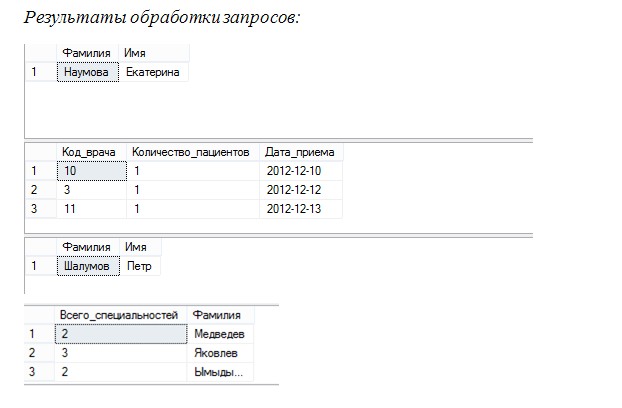Laboratory work on the database in SQL Server
Sold 3
Refunds 0
Good feedbacks 0
Bad feedbacks 0
For example, the basic principles of working with databases in Microsoft SQL Server. Creating and filling tables, delete, and modify records in a table, create different queries and procedures.
Subject: 'Clinic Reception patients. ".
Number of tables: 6
Laboratory work №1: Creating and populating database tables.
In one lab are given scripts to create the tables 6, as well as the outcome of their treatment.
Laboratory work №2: Creating and populating database tables.
2 In the laboratory work the scripts to populate the tables, change field content changes to certain incorrect entries, delete entries from the table, delete all records from the table.
Laboratory work №3: Development in the query language QBE
The example shows the following queries and their results:
1. List of patients, physicians received yesterday
2. Doctors, combining different specialties
3. The number of patients taken by each of the doctors in the past year
4. The doctors who took the least patients
5. Physicians who have received the number of patients exceeds the average
6. Patients who have never visited a surgeon
7. Patients attending and surgeon and cardiologist.
Laboratory work №4: Development in SQL queries. Part 1.
The example shows the following queries and their results:
1. Patients who visited a surgeon and cardiologist
2. The number of patients taken by each of the doctors in the past year
3. List of patients received yesterday terapevatami
4. The doctors combine more than one specialty.
Laboratory work №5: Development in SQL queries. Part 2.
The example shows the following queries and their results:
1. The number of patients taken by each of the doctors in the past year
2. Doctors who took the least patients
3. Physicians who have received the number of patients exceeds the average
Laboratory work №6: Development in SQL queries. Part 3.
The example shows the following queries and their results:
1. Patients who have never visited a surgeon
2. Patients who visited all specialists
3. Doctors do not combine work in different specialties (listed 2 possible ways to implement a query).
Laboratory work №7: Creating Stored Procedures for entering / retrieving data
The example shows the following procedures:
1.Vstavka with the completion of the directory
2.Kaskadnoe removal and removal of checking referential integrity
3.Statistika
3.1 calculates what percentage of patients received one of the doctors
3.2 Create a procedure to select a random doctor
Subject: 'Clinic Reception patients. ".
Number of tables: 6
Laboratory work №1: Creating and populating database tables.
In one lab are given scripts to create the tables 6, as well as the outcome of their treatment.
Laboratory work №2: Creating and populating database tables.
2 In the laboratory work the scripts to populate the tables, change field content changes to certain incorrect entries, delete entries from the table, delete all records from the table.
Laboratory work №3: Development in the query language QBE
The example shows the following queries and their results:
1. List of patients, physicians received yesterday
2. Doctors, combining different specialties
3. The number of patients taken by each of the doctors in the past year
4. The doctors who took the least patients
5. Physicians who have received the number of patients exceeds the average
6. Patients who have never visited a surgeon
7. Patients attending and surgeon and cardiologist.
Laboratory work №4: Development in SQL queries. Part 1.
The example shows the following queries and their results:
1. Patients who visited a surgeon and cardiologist
2. The number of patients taken by each of the doctors in the past year
3. List of patients received yesterday terapevatami
4. The doctors combine more than one specialty.
Laboratory work №5: Development in SQL queries. Part 2.
The example shows the following queries and their results:
1. The number of patients taken by each of the doctors in the past year
2. Doctors who took the least patients
3. Physicians who have received the number of patients exceeds the average
Laboratory work №6: Development in SQL queries. Part 3.
The example shows the following queries and their results:
1. Patients who have never visited a surgeon
2. Patients who visited all specialists
3. Doctors do not combine work in different specialties (listed 2 possible ways to implement a query).
Laboratory work №7: Creating Stored Procedures for entering / retrieving data
The example shows the following procedures:
1.Vstavka with the completion of the directory
2.Kaskadnoe removal and removal of checking referential integrity
3.Statistika
3.1 calculates what percentage of patients received one of the doctors
3.2 Create a procedure to select a random doctor
The archive contains records of each laboratory work, as well as scripts that are used during the work.

